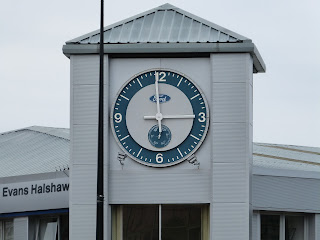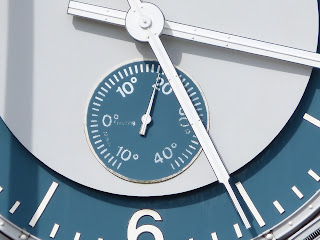The building was officially opened on 16 September 1933, although it was originally known as Stretford Town Hall. Local government reorganisation in 1974 led to the change of name.
Although the clock face is quite impressive, with the hour dashes cheekily painted in Manchester City colours, the open nature of the dial set against the tower windows, and the design of the hands themselves, means that the overall visual effect is not as good as it could be and is certainly not good for telling the time at a glance. This is a clock that demands a good hard stare.
You will also notice, whilst giving your hardest, longest stare, that at least one face is not telling the correct time. So all in all, better to have your own watch in these parts.
Trafford Town Hall stands by one main road junction. At the next one in our northerly journey stands the motor dealers Evans Halshaw. (And note the pub sign that indicates we are on the right route to the football stadium).
This is one impressive clock, marred only by the poor positioning of the lamp column which does not obscure the face but detracts from the overall ambiance.
Now this is a clock where you can tell the time at a glance. The smaller dial, by the way (and the way in which it is by is Sir Matt Busby Way), is a thermometer.
Onwards then to Old Trafford stadium itself, home of course to Manchester United.
And the clock is of course a memorial to those killed in the Munich air crash in 1958.
Destination reached, it is now time to retrace my steps back to the tram stop. From where you can peek into the Lancashire County Cricket Ground to see its pavilion clock.


















It seems the Trafford Town Hall clock is best viewed in the dark. The clock dial and hands were illuminated by neon, the latest and greatest gadget from Gillet & Johnston when it was installed. Just the thing for being seen in the smog.
ReplyDelete